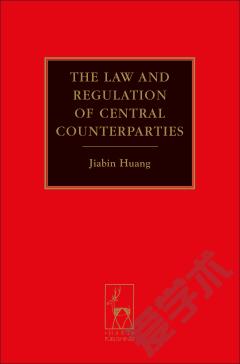The Law and Regulation of Central Counterparties
1 Introduction 1.1 The Purpose and Scope 1.2 The Chapters in Outline 2 Basic Elements of Post-trade Infrastructure 2.1 Introduction 2.1.1 The Importance of Post-trade Infrastructure 2.1.2 The Changing Landscape of Post-trade Infrastructure A. Central Counterparty B. Clearing C. Settlement 2.2 Payment Systems and Securities Settlement Systems 2.2.1 Introduction 2.2.2 Payment Systems 2.2.3 Securities Settlement Systems 2.3 Modern Indirect-holding Structure and Book-entry Securities 2.3.1 Introduction 2.3.2 Indirect-holding Structure 2.3.3 Book-entry Securities 2.3.4 Transfer of Book-entry Securities 2.3.5 Concluding Remarks 2.4 Relevant Developments in Shaping the Future of Post-trade Infrastructure 2.4.1 Delivery Versus Payment (DVP): Horizontal Linkage between Payment and Securities Settlement Systems, Various Forms of DVP A. UK CREST B. CREST DVP Process C. Self-collateralisation in CREST 2.4.2 Straight-Through Processing (STP): Vertical Linkage between Different Tiers of Holding Systems A. The Drive towards STP B. Benefits C. Challenges D. The Role of CCPs in STP Process E. Market Development 2.4.3 Concluding Remarks 2.5 The Future of Post-trade Infrastructure 3 The Functional and Operational Aspects of Central Counterparties 3.1 Origins and Historical Development 3.1.1 Cheque Clearing 3.1.2 Commodity Clearing 3.1.3 Central Counterparty Clearing 3.1.4 Concluding Remarks 3.2 The Functional Aspects of CCPs 3.2.1 CCP as Risk Manager 3.2.2 CCP as Fund Manager 3.2.3 CCP as Payment and Settlement System Operator 3.2.4 CCP as Post-trade Market Facilitator 3.3 The Operational Aspects of CCPs 3.3.1 Risk Operations 3.3.2 Treasury Operations A. Specially Arranged Payment Scheme B. Margining Operations C. Operations for Other Services 3.3.3 Settlement Operations for CCPs A. Trade Registration B. Pre-netting C. Netting Process D. Post-netting E. Settlement F. Major Factors that Affect Settlement Operations G. UK CREST 3.4 Concluding Remarks 4 Legal Issues: The Key Relationships 4.1 Introduction 4.1.1 Trading Rules and Clearing Rules A. Trading B. Trading/Exchange Rules v CCP Clearing Rules C. The Timing Issue 4.1.2 The Conditions for Transaction Acceptance/Registration 4.1.3 The Results 4.2 Overview of the Key Relationships 4.3 The Relationship between CCPs and Their Members 4.4 The Relationship between Clearing Members Themselves 4.5 The Relationship between Clearing Members and Their Clients 4.5.1 The Nature of the Relationship 4.5.2 Implied Terms and The Relationship between the Two Different Clearing Arrangements 4.5.3 The Legal Position of Clearing Members affected by CCP Clearing 4.6 The Position of Clients of Clearing Members 4.6.1 The Effectiveness and Implications of Implied Terms: Clearing Rules and Regulations as Implied Terms 4.6.2 The Rights of Clients of Clearing Members 4.7 The Relationship between CCPs Themselves 4.8 Concluding Remarks 5 Default Procedures and Default by a CCP 5.1 Collateralisation and Financial Collateral Arrangements 5.1.1 Types of Collateral 5.1.2 The Use of Collateral A. Collateralisation in DVP Arrangements B. Collateralisation in Payment Systems C. Collateralisation in CCPs 5.1.3 The Limitation of Collateralisation 5.1.1 Characterisation and Realisation 5.1 Netting and Set-off 5.2.1 Netting 5.2.2 Definition and Distinctions 5.2.3 Settlement Netting 5.2.4 Novation Netting 5.2.5 Close-out Netting 5.2 Default by A Clearing Member 5.3.1 Commencement of Default Procedures A. The Prescribed Events that Trigger Default Procedures B. Procedures to be Followed C. Close-out of Positions 5.3.2 The Effect of Default Procedures on Other Clearing Members and Third Parties 5.3 Default by a CCP 5.4 Concluding Remarks 6 Regulatory Issues 6.1 The Purposes and Objectives of Financial Regulation 6.1.1 The Purposes and Objectives of Financial Regulation 6.1.2 The Interaction between Financial Regulation and the Markets 6.2 Regulatory Approaches 6.2.1 The Modes of Financial Regulation 6.2.2 The Risk-based Functional Approach 6.2.3 The Interest of Central Banks 6.3 CCPs and the Regulatory Regime 6.3.1 The Need for Separated Treatment for CCPs 6.3.2 CCPs as Self-Regulatory Organisations 6.3.3 The UK Regulatory Regime A. Market Contracts, Market Charges and Default Rules B. Roles of Relevant Authorities C. Competition Issues: A Special Competition Regime D. The Effect of Recognition 6.4 Current Situation in the European Union 6.4.1 The Current EU Initiatives 6.4.2 The EU Directives A. Directive on Settlement Finality B. Directive on Financial Collateral Arrangements C. Markets in Financial Instruments Directive (MiFID) 6.4.3 The Challenges to the EU Regulators and Supervisors 6.5 Concluding Remarks 7 The Case for a Single Multi-market Central Counterparty 7.1 Advantages and Disadvantages of CCP Clearing 7.1.1 From the Markets' Perspective 7.1.2 From Members' Perspective 7.1.3 From Non-members' Perspective 7.1.4 Concluding Remarks 7.2 The Case for a Single Multi-market Central Counterparty 7.2.1 The Raison D'etre for a Single Multi-market CCP 7.2.2 The Benefits of a Single Multi-market CCP 7.2.3 The Risks of a Single Multi-market CCP 7.2.4 The Global CCP Initiative 7.3 European Union Developments 7.3.1 The Current Situation 7.3.2 The Argument for a Single Pan-European CCP 7.3.3 Future Prospects 7.4 Concluding Remarks 8 Conclusions 8.1 Modern Post-trade Infrastructure 8.2 The Legal and Regulatory Framework 8.3 A Single Multi-market CCP Select Bibliography Index
{{comment.content}}








 京公网安备 11010802027623号
京公网安备 11010802027623号